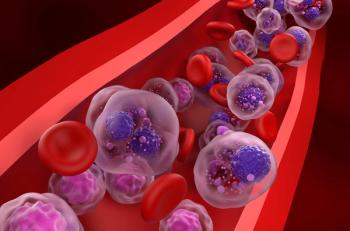
Gene Therapy Shows Promise for Ovarian Cancer Treatment in New Study
The recent analysis of VB-111 was a phase 3 potential registration study conducted with 400 patients and 95 sites around the world.
A novel anticancer gene therapy has shown potential for treating platinum-resistant ovarian cancer. A recent study found ofranergene obadenovec (VB-111, VBL Therapeutics), a first-in-class targeted therapy, to be well tolerated in more than 300 patients with cancer.1
Results of the analysis were presented during the virtual scientific program of the 2020 American Society of Clinical Oncology (ASCO) Annual Meeting.1,2
VB-111 is administered by intravenous infusion once every 6-8 weeks. The drug has a dual mechanism of action: apoptosis of angiogenic endothelium and vascular disruption that leads to tumor starvation and induction of an antitumor-directed immune response.1
The recent analysis of VB-111 was a phase 3 potential registration study conducted with 400 patients and 95 sites around the world. The primary endpoint was overall survival (OS), with secondary endpoints of progression-free survival, CA-125 and RECIST response.1
This study compared the CA-125 objective response rate (ORR) according to Gynecologic Cancer InterGroup criteria in the treatment and control arms among the first 60 evaluable patients. According to VBL Therapeutics, the CA-125 ORR in those patients was 53% and, assuming a balanced randomization, the response rate in the treatment arm (VB-111 in addition to weekly paclitaxel) was 58% or higher. In patients who had post-dosing fever—a marker for VB-111 treatment—the response rate was 69%.1,2
“The OVAL interim data are very encouraging as they demonstrate the potential benefit of VB-111 over standard-of-care in a randomized-controlled setting,” said Tami Rachmilewitz, MD, vice president of Clinical Development of VBL Therapeutics, in a prepared statement.2
The CA-125 response rate observed in the phase 3 interim analysis is at least as good as the response rate seen in the prior phase 2 study that enrolled a similar patient population and showed OS benefit, according to researchers. In the previously reported phase 2 study of VB-111 in platinum-resistant ovarian cancer, 58% of the patients treated with VB-111 and paclitaxel demonstrated a CA-125 response. Those patients with a CA-125 response demonstrated a median OS of 808 days, compared with survival of 351 days for those patients without a CA-125 response.2
The most recent study was conducted in collaboration with the GOG Foundation, an independent not-for-profit organization that aims to promote excellence in the quality and integrity of clinical and basic scientific research.2
Further interim analysis is expected to be conducted in the third quarter of 2020.1
“With over 25% of the patients already enrolled in the study, we look forward to further advancing the OVAL study by expansion to Europe and Japan later this year,” Rachmilewitz said in a prepared statement.2
REFERENCES
- Pivotal Study of VB-111 Combined with Paclitaxel vs. Paclitaxel for Treatment of Platinum-Resistant Ovarian Cancer (OVAL, VB-111-701/GOG-3018): Results of Pre-planned CA-125 Response Interim Analysis. Presented at: 2020 ASCO Annual Meeting, Virtual Science Program. May 29-31, 2020.
- VBL Presents Positive Interim Data from the OVAL Phase 3 Pivotal Study in Ovarian Cancer at the ASCO20 Annual Meeting, Showing 58% or Higher Objective Response Rate [news release]. Tel Aviv, Israel; June 1, 2020: VBL Therapeutics website. http://ir.vblrx.com/news-releases/news-release-details/vbl-presents-positive-interim-data-oval-phase-3-pivotal-study Accessed June 4, 2020.
Newsletter
Stay informed on drug updates, treatment guidelines, and pharmacy practice trends—subscribe to Pharmacy Times for weekly clinical insights.









































































































































































































